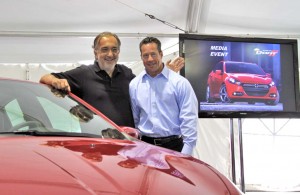“Everything is on the table,” says Chrysler CEO Sergio Marchionne.
The Italian-born, Canadian-educated executive could have been referring to any number of topics as he met with reporters this week at Chrysler’s massive proving grounds in Chelsea, Michigan. The wide-ranging discussion covered everything from the auto industry’s slump in Europe to the unexpectedly strong sales of the maker’s new Dodge Dart sedan.
But the most immediate subject was fuel economy, the White House issuing long-awaited guidelines that will bump the Corporate Average Fuel Economy, or CAFE, standard to 54.5 miles per gallon in 2025.
Chrysler was one of 13 major manufacturers that agreed to support the proposal, albeit reluctantly. But now that the rules were in place, Marchionne acknowledged it won’t be easy getting there. To the average American, 2025 is a long way away. In the automotive world, it’s barely two product cycles. And getting to 54.5 mpg by then “will significantly change the way this industry operates,” Marchionne stressed.
For one thing, don’t expect to see many more Hemi-powered Dodge Challengers. Big V-8 muscle cars will become “as rare as white flies,” he suggested.
Then again, the naysayers who have been predicting doom-and-gloom, a forced transition to battery-powered minicars, might want to look at some of the other products in the rapidly changing Chrysler line-up. That includes the 2013 Dodge Dart. The Aero package delivers as much as 40 miles a gallon on the highway – the sort of numbers a minicar like the Fiat 500 might have struggled to achieve only a few years back.
While there’s little doubt the industry will have to make increased use of electric propulsion technology in the coming years there’s a lot more low-hanging fruit to be plucked before 2025. The Dart, for example, makes extensive use of underbody panels that reduce aerodynamic drag. Buyers also can opt for the new DDCT, essentially an electronically-shifted manual gearbox, to further improve mileage without sacrificing the fun-to-drive factor.
And starting next year, Marchionne revealed, Chrysler will launch its new 9-speed automatic transmission with the replacement for the Jeep Liberty model. And, “if I get my way we’ll have it on all our front-drive models” within a few years, he said in response to a question from TheDetroitBureau.com.
One technology Marchionne clearly doesn’t like is electrification. He had particularly harsh words for pure battery-electric propulsion — which will be offered in a new version of the Fiat 500 coming next year. Battery cars, he sniffed, are “economic lemons. I lose money on every one we sell.”
Marchionne, who also serves as CEO for Chrysler’s Italian alliance partner, said he was pleased by the surge in demand for the little Fiat 500 which had gotten off to a painfully slow start after its December 2010 launch.
But the real sales story appears to be the Dart, which has been posting 300% monthly sales gains since its spring introduction. The new compact sedan – which was based on a platform developed for Fiat’s European model, the Alfa Giulietta – is expected to finish August topping 3,000 sales in the U.S. and Canada. And Dodge brand boss Reid Bigland later told TheDetroitBureau.com that it could be 3,000 for the U.S. alone.
Dodge is charting still more growth in September as production at the Dart plant in Belvidere, Illinois continues to ramp up. But executives stressed there is little likelihood they can maintain the 300% month-over-month pace much longer. Even so, Bigland chided his boss that he may need more capacity. Sell enough Darts, Marchionne responded, “and I’ll build you another plant.”
That’s precisely what Fiat doesn’t need in Europe. Even before the current European economic crisis led to a collapse of Continental car sales, industry analysts were estimating there were at least 10 plants too many operating in that market.
The problem, said Marchionne, “It’s like a game of poker (where) no one wants to call anyone else’s bluff” and be the first to start closing plants. In the world of technology, there’s often a so-called first-mover advantage. Being first with a breakthrough product, like an iPad, can be a big plus for a company such as Apple. But being the first to close plants and cut capacity can be a big disadvantage for an automaker, Marchionne lamented.
He called on European Union regulators to step in and oversee a “fair” effort to rationalize the auto industry that won’t unduly burden one company or any particular country.
“It’s time for Europe to stand up and be Europe,” he insisted. “If it doesn’t want to then it’s time to bust it (the EU) up.”
While Europe may be the toughest market, right now, Marchionne said he believes the industry, as a whole, will find it tough going just about everywhere in the next half-decade or more. About the only market where he said he sees growth is in Brazil, where a fast-emerging middle class could drive up demand by as much as 1 million vehicles in the next five years or so.
A stagnant global market means manufacturers like Fiat/Chrysler will have to seek “efficiencies” wherever possible. Among other things, they’ll look for ways to share more common platforms that can each be used for a variety of different models.
Asked whether he was worried about the resurgence of the Japanese, who lost significant momentum in the wake of that country’s March 2011 earthquake and tsunami, Marchionne said he would never be one to count makers like Toyota or Honda out. Underestimating the Japanese would be a ruinous mistake. “Eventually, they’d crawl up your pant leg and you’d find them where you didn’t want them.”

